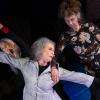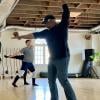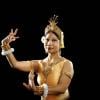
The return of Nancy Karp + Dancers to the Taube Atrium Theater April 6–7, 43 years since the company last performed at the venue, is cause for celebration. Dance and music aficionados, as well as nature lovers, will be thrilled with the program’s two works, which respond in distinct but interconnected ways to constructed and natural environments.
The first work, Eppur si muove, was inspired by Karp’s fascination with orbital patterns and circular spaces and is set to an expanded version of Sundial, Samuel Adams’s string quartet with percussion. The evening’s longer work is a reprise of fly through the night, and land near dawn, which premiered in October 2022 at Dresher Ensemble Studio and marked Nancy Karp + Dancers’ 40th anniversary. The music, by Berkeley-based composer David A. Jaffe, combines two pieces written in 1983 and 2013 with a third and final movement commissioned by Karp.
Both works will be performed by Friction Quartet, joined by guest percussionist Haruka Fujii for the Adams and by Jaffe on mandolin and mandocello for his own work.

In a recent phone interview, Jaffe spoke about the distinguishing and related features of his score. “I met with Nancy a lot before we started,” he said. “There was experimentation and exploration of what the first two pieces should be. We settled on [Fox Hollow, a string quartet from 2013, and String Quartet for Two Instruments, from 1983] before I started on the third piece, which was written as both a standalone piece but also as the conclusion of the entire piece. Nancy was interested in a [rhythmic] pattern of 3-3-2-3, which comes out to 11. So I ran with that. The piece has that [meter] throughout the whole structure. The first piece is varied in tempo, the second piece is slow, and I wanted the third piece to be a quick, exciting conclusion.” Fragments of material from the first piece return in the final section, reprising themes heard in the opening. Jaffe calls the work “a sort of Balkan-bluegrass fusion.”
The mandocello is tuned like the cello, and together, the two instruments offer interesting combinations of melody and texture. Rhythmic groupings derived from the 11/8 meter set the work akilter, but the overall structure keeps the dancers in mind. “My movement tends to have diversity and variability, with material growing out of other material. You don’t know how you got from one place to another, but it makes sense when you get there,” Jaffe said. “Nancy requested I write some larger sections so the dancers have time to settle in before the music changes. I was conscious of writing rhythms possible for dancers to latch onto.”
The middle section is based on an old Yiddish folk tune, and here, Jaffe weaves family history into the mix. His father was a native Yiddish speaker (and a skilled mandolinist) and introduced Jaffe to an assortment of folk music from Eastern Europe. “This particular song I actually first heard Pete Seeger playing on the recorder and singing [a cappella] the words by Hirsh Glick, one of the partisans in World War II. Glick wrote resistance songs. It’s a simple theme, minor key, with a plaintive quality. As a separate idea, I had the Bach unaccompanied violin sonatas in mind. I was thinking, as a violinist, it’s so tricky to play that way — one instrument with multiple voices — because the notes played have to lie on the hand in a way they can be played together. They have to be adjacent to each other.”
The result, with violin and viola each playing two parts, is reminiscent of a fugue. The four parts are written out but sound improvisational, with a certain rhythmic freedom that emerges, along with whimsical, dreamlike impressions.
About the entire work, Jaffe said his experiences at the Fox Hollow Folk Festival decades ago continue to resonate and inspire him. Concerts held every night at the festival often extended into impromptu meetups in the wee hours and led to all manner of collaborative, cacophonous music-making.
The rich traditions of Jaffe’s ancestry, training, and passion for experimentation parallel Karp’s choreography, which in its simple-seeming themes and structures ultimately embodies the complexities of movement, sound, nature, and human interaction. Following the matinee performance on April 7, the audience is invited to participate in a talkback with the artists.




